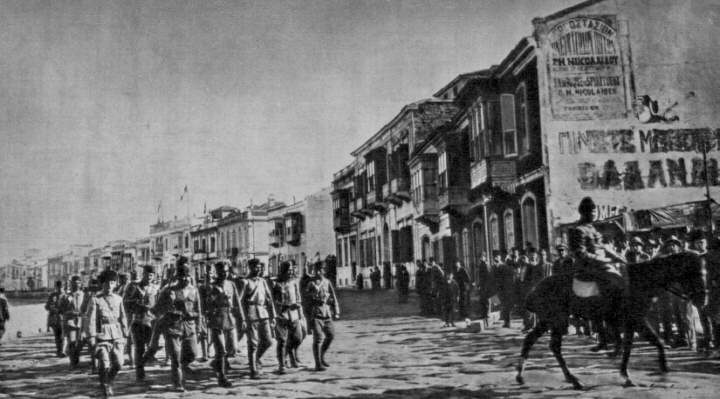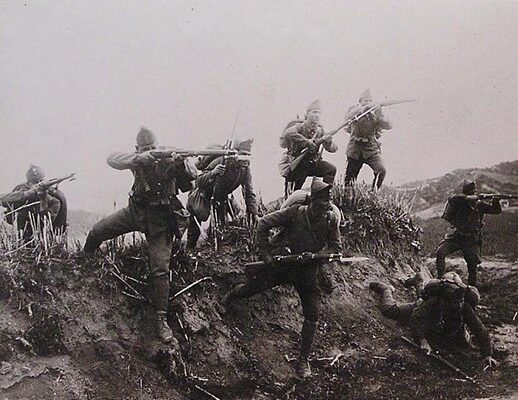Overview
Background
Following their defeat in World War One, the Ottoman Empire had been reduced to a shell of its former self. The only territory they held on to now in 1919 was Turkey itself, and even that was under threat, particularly from Britain, France, Italy, and Greece. The Greeks had ambitions to take lands in western Turkey, which housed a sizable Greek Christian population1Philip S. Jowett, Armies of the Greek-Turkish War (1919-1922) (Great Britain: Osprey Publishing, 2015), 4.. The Greeks wished to “liberate” these populations from the Turks. The British and French supported such an invasion, while the Italians did not as they had their own ambitions for those lands.
Greek Invasion
On May 15, 1919, the Greek army landed in the city of Smyrna. The Greeks met little resistance from the Turks, as the Turks were already occupied with holding off the French on their southern border, and dealing with an Armenian and Kurdish uprising2Peter Kincaid Jensen, “The Greco-Turkish War, 1920-1922”, International Journal of Middle East Studies 10, no. 4 (1977): 554. This would soon change by May 1920 when Turkish forces under the leadership of Mustafa Kemal Atatürk would push back the French, crush the Kurds, and cripple the Armenians. Now the Turks were being funded and armed by the Italians, who were doing so to spite the Greeks. The Turks would now be able to start to organize a defense against the Greeks, but it would prove to be too late. On July 21, the Greeks, supported by the British, would launch a massive offensive into Turkey, forcing the Turks into full retreat. Constantinople was now occupied by the British. By the end of August, all of western Turkey was under Greek or British control, and the offensive was halted to prepare for a new offensive in the autumn. However, the Turks were now receiving support from Soviet Russia, and they managed to finish off the Armenians. The Greeks began a new offensive in October, however this offensive was halted due to political pressure from the French and Italians3Jensen, “The Greco-Turkish War”, 557.. The French promptly withdrew their support of the Greeks, now leaving Britain as their sole supporter. The Turks used this time to reorganize their army, and by 1921, it was now a force that could match the Greeks.

The Turks Turn the Tide
On January 6, 1921 the Greeks would launch another offensive. The Turks managed to halt the Greek attack at İnönü, signaling the first Turkish victory of the war. The Greeks tried to attack again in March, but were once again beaten back at İnönü. Now, the French expressed their formal support of the Turks, and the British had withdrawn their support of the Greeks, leaving them alone, while the Turks now had the support of the Italians, Soviets, and French4]Jensen, “The Greco-Turkish War”, 558.. This however, did not dissuade the Greeks, and they launched another offensive in July 10. This attack would prove to be a success and the Turks were forced to retreat. Now the Turkish capital of Ankara was in danger. The Greeks launched an attack in August with the intent of finishing the Turks once and for all, with the Greeks outnumbering the Turks 3 to 15]Jensen, “The Greco-Turkish War”, 560.. After nearly a month of vicious fighting, the likes of which had not been seen since World War One, the Turks emerged victorious and had held off the Greeks. This defeat proved to be disastrous for the Greeks, who now struggled to financially support the war without the backing of the major European powers. However, the Greeks refused to give in.
The End of the War
The war was in a stalemate for nearly a year. Then on August 26 1922, the Turks finally launched an offensive of their own. The Greeks were devastated by this attacked and were quickly forced into retreat. A mere 15 days after the start of the offensive the Turks had managed to retake nearly all of the territory that they had lost from the Greeks6]Jensen, “The Greco-Turkish War”, 564.. On September 9, Turkish troops entered Smyrna. The war was effectively over at this point, but the armistice would not be signed until October 11.

Atrocities
This war was plagued by ethnic cleansing and violence on both sides. The Turks massacred Armenian and Greek civilians. Estimates for the number of dead go into the hundreds of thousands. When Smyrna was taken back by the Turks, attacks on the Christian populace were common. After a few days, fire broke out and destroyed half of the city. It is unknown whether the fire was started on purpose or not7]Jensen, “The Greco-Turkish War”, 564.. The Greeks started committing atrocities against the Turkish citizens as soon as the invasion began, however the numbers involved were much lower than what the Turks were doing. When the Greeks were retreating westward at the end of the war, they enacted a scorch-earth policy, and razed many towns and villages to the ground. These acts would fuel violence from the Turks. The level of violence displayed was part of the motivation for the Lausanne Peace Treaty, where a significant part of it was a population exchange between Greece and Turkey, where Christians living in Turkey would be moved to Greece and Muslims living in Greece would be moved to Turkey8Republic of Turkey Ministry of Foreign Affairs, “Lausanne Peace Treaty VI. Convention Concerning the Exchange of Greek and Turkish Populations Signed at Lausanne, January 30, 1923” 2011..
Significance
This war shows off the short-term effects of World War One better than anything else. Particularly, how “The War To End All Wars” ended nothing. The Ottoman Empire was gone after World War One, but that apparently was not enough for these other countries, who had the desire to see Turkey wiped off the map. The result was another incredibly bloody war starting before the Treaty of Versailles was signed. However, the Greco-Turkish War did differ from World War One for one important reason: this war was racially charged. This war started for racial reasons. The Greeks wanted the ethnically Greek populations in Turkey to be under their rule. There was true hatred between the two sides, which was demonstrated through the shear amount of atrocities committed by both sides. This was a sign of things to come. Wars would become more and more racially and ethnically charged with atrocities against civilians becoming more and more common, with World War Two being a prime example. The Greco-Turkish War was a warning as the how out-of-hand modern wars could get if they are waged along racial lines, and this warning was ignored.
Citations
Bibliography
- Jensen, Peter Kincaid. “The Greco-Turkish War, 1920-1922.” International Journal of Middle East Studies 10, no. 4 (1979): 553-65. Accessed April 20, 2021. http://www.jstor.org/stable/162217.
- Jowett, Philip S. Armies of the Greek-Turkish War (1919-1922). Great Britain: Osprey Publishing, 2015.
- Republic of Turkey Ministry of Foreign Affairs, “Lausanne Peace Treaty VI. Convention Concerning the Exchange of Greek and Turkish Populations Signed at Lausanne, January 30, 1923”. 2011. Accessed April 20, 2021. https://www.mfa.gov.tr/lausanne-peace-treaty-vi_-convention-concerning-the-exchange-of-greek-and-turkish-populations-signed-at-lausanne_.en.mfa

Nicholas Buonocore is a student at Ramapo College who toke the Discovering Digital History course in the Spring 2021 semester. He was a junior at Ramapo studying history while taking this course.

